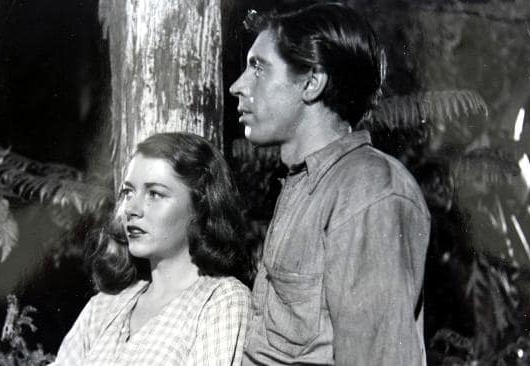SONS OF MATTHEW



12:30PM, Saturday 16 October, Classic Cinemas Elsternwick.
Introduced by Adrian Danks
Director: Charles Chauvel
Country: Australia
Year: 1949
Runtime: 101 minutes
Language: English
Format: B&W
Rating: G
Introduced by Adrian Danks
Director: Charles Chauvel
Country: Australia
Year: 1949
Runtime: 101 minutes
Language: English
Format: B&W
Rating: G
Tickets ⟶
“
Sons of Matthew is formally, and thematically, one of the most significant films in the
history of the Australian film industry
.” —
Geoff Mayer, The Oxford Companion
to Australian Film.
A tale of rugged pioneer days, Sons of Matthew director Charles Chauvel gave the lead role to the young Michael Pate. As with the earlier Chauvel discovery, Errol Flynn, the film’s success hurtled the actor towards a long career in Hollywood. This remarkable tale follows three generations of the O'Riordan family as they work together to survive the harsh realities of rural Australian life.
“This film is quintessentially Chauvel, combining the strongest factors in his personality. His reverence for the soil and the pioneer spirit is clear in the story of a young couple settling down on a “lost world” plateau in Queensland and raising a family despite drought, fire and natural obstacles.” — John Baxter, The Australian Cinema.
Presented in a 2K restoration by the National Film and Sound Archive of Australia as part of NFSA Restores.
![]()
A tale of rugged pioneer days, Sons of Matthew director Charles Chauvel gave the lead role to the young Michael Pate. As with the earlier Chauvel discovery, Errol Flynn, the film’s success hurtled the actor towards a long career in Hollywood. This remarkable tale follows three generations of the O'Riordan family as they work together to survive the harsh realities of rural Australian life.
“This film is quintessentially Chauvel, combining the strongest factors in his personality. His reverence for the soil and the pioneer spirit is clear in the story of a young couple settling down on a “lost world” plateau in Queensland and raising a family despite drought, fire and natural obstacles.” — John Baxter, The Australian Cinema.
Presented in a 2K restoration by the National Film and Sound Archive of Australia as part of NFSA Restores.

Film Notes by Andrew Pike and Ross Cooper
Excerpt from Australian Film 1900-1977 by Andrew Pike and Ross Cooper. Reprinted by permission of the authors.
Sons of Matthew was an epic story of Australian pioneer life, tracing the story of three generations of settlers in rugged frontier land. Matthew and Jane O’Riordan raise a family of five sturdy sons and two daughters on the farm in the valley of Cullenbenbong…
Queensland was Chauvel’s home state and he had long been inspired by the life story of the pioneering O’Reilly family who had settled in the mountains of the south-east of the state.
Bernard O’Reilly had written two books about his family’s life – Green Mountain (Brisbane, 1940) and Cullenbenbong (Brisbane, 1944). In 1945 Chauvel acquired the screen rights to the books and commissioned Maxwell Dunn and the radio writer Gwen Meredith, to prepare a screenplay about the O’Reillys and the rescue of survivors from the crash of a Stinson aeroplane in the mountains in February 1937.
Gradually, however, Chauvel turned towards the characters of the O’Reillys themselves, and by the end of 1946 had settled on his own simple story of pioneers in a spectacular new frontier.
The story of making the film was itself a tale of great perserverance in the face of formidable physical odds. Chauvel’s usual financial backer, Herc McIntyre of Universal Pictures, succeeded in persuading Norman Rydge of Greater Union (no great advocate of local production) to join him as a partner in financing the film. A crew was assembled with a core of technicians from Cinesound and early in March 1947 the large unit of 70 people, including the cast, set off for the main location site near the town of Beaudesert in the heart of the wild mountain terrain.
Their arrival coincided with one of the worst wet seasons on record and the first three months on location saw scarcely three weeks of weather suitable for filming. This major setback to morale and to the shooting schedule was aggravated when work began in earnest and it became clear that the terrain was far more treacherous than had ever been anticipated. For six months the unit worked under very trying conditions, sometimes travelling by pack-horse and foot to reach remote location sites. Changes to the script also provided unexpected extensions to the shooting schedule, and eventually a second camera unit, under the direction of Carl Kayser, was brought on to the location to accelerate the work. The delays caused anxiety to Chauvel’s backers and Rydge and McIntyre both travelled up to the location to inspect progress; Rydge has recounted how he came so close to abandoning the production that he actually tossed a coin to decide whether he would continue to support it….
Shooting was finally completed some eighteen months after it began…The arduous months of the production revealed more clearly than ever before Chauvel’s passionate urge to risk any cost and hazard in expressing his deeply nationalistic vision of a people in their struggle to conquer the most hostile of terrains. His methods were somewhat vindicated, however, by the emotional power of the film’s best scenes and by its commercial success.
Courtesy of Umbrella Films.
Credits
Dir: Charles CHAUVEL | Australia
| 1949 | 101 mins. B&W | Sound | Eng. | DCP (originally35mm) | G.
Prod Co: Charles Chauvel Productions, Greater Union, Universal Pictures| Prods: Charles CHAUVEL, Elsa CHAUVEL (“Associate Producer”) | Scr: Charles CHAUVEL , Elsa CHAUVEL , Maxwell DUNN, from the novel by Bernard O’Reilly | Photo: Carl KAYSER , Bert NICHOLAS | Edit: Terry BANKS | Des/Art: George HURST | Sound: Allyn BARNES | Music: Henry KRIPS | Assist Dir: Alec KELLAWAY.
Cast: Michael PATE (Shane O’Riordan), Ken WAYNE (Barney O’Riordan), Tommy BURNS (Luke O’Riordan), John UNICOMB (Terry O’Riordan), John EWART (Mickey O’Riordan), Wendy GIBB (Cathy McAllister), John O’MALLEY (Matthew O’Riordan), Thelma SCOTT (Jane O’Riordan).
Prod Co: Charles Chauvel Productions, Greater Union, Universal Pictures| Prods: Charles CHAUVEL, Elsa CHAUVEL (“Associate Producer”) | Scr: Charles CHAUVEL , Elsa CHAUVEL , Maxwell DUNN, from the novel by Bernard O’Reilly | Photo: Carl KAYSER , Bert NICHOLAS | Edit: Terry BANKS | Des/Art: George HURST | Sound: Allyn BARNES | Music: Henry KRIPS | Assist Dir: Alec KELLAWAY.
Cast: Michael PATE (Shane O’Riordan), Ken WAYNE (Barney O’Riordan), Tommy BURNS (Luke O’Riordan), John UNICOMB (Terry O’Riordan), John EWART (Mickey O’Riordan), Wendy GIBB (Cathy McAllister), John O’MALLEY (Matthew O’Riordan), Thelma SCOTT (Jane O’Riordan).
